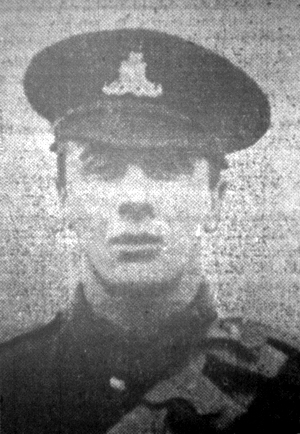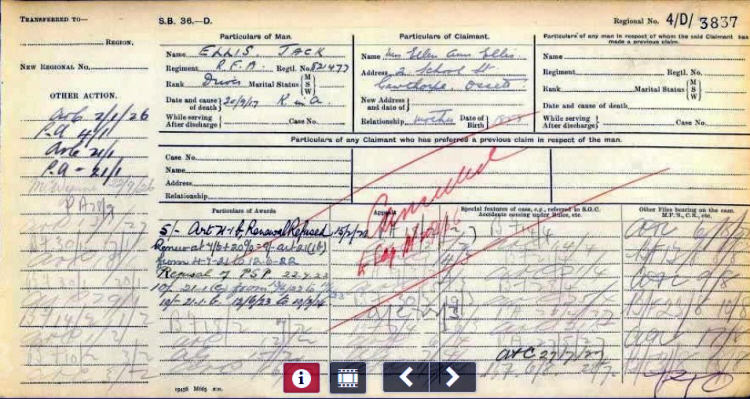
In May 2020 it was discovered that Joshua John Ellis served in the army as Jack Ellis. This caused confusion to the army records and also to the 1928 listing of Ossett men who had lost their lives in WWI. Joshua John and Jack Ellis are one and the same man.
An explanation of the circumstances is provided below:
In common with many other Ossett men who died in WWI John Ellis and Joshua Ellis were first researched in April 2014. Their names were included in the 230 names recorded in the Commemoration Programme issued in 1928 for the unveiling of the Ossett War Memorial on 11th November of that year.
In addition to John Ellis and Joshua Ellis the 1928 Commemoration Programme also included the name John W. Ellis. Whilst the research of John William Ellis proved relatively straightforward, attempts to corroborate the existence of John Ellis, who we believed to be known as “Jack”, and Joshua Ellis proved problematical.
Nonetheless a full biography was written for Jack Ellis and a much shorter biography was compiled for Joshua Ellis suggesting his identity but acknowledging that we knew nothing about his war service or his death.
Since the 1928 Commemoration Programme included the names, John, John W. and Joshua Ellis, it was proper that the names engraved at the Ossett War Memorial should reflect that act of remembrance. Hence the names John Ellis, John W. Ellis and Joshua Ellis are included at the Ossett War Memorial. The name Jack Ellis was not remembered in 1928 and his name is not included on the Ossett War Memorial.
The name Joshua J. Ellis is also included on the St. Mary’s Church Gawthorpe Roll of Honour. The name Jack Ellis is not included on any Ossett Roll of Honour.
By May 2020 further WWI records had become available and we revisited Jack Ellis and Joshua Ellis. It became evident that they were one and the same man.
The Pension Record Cards for Joshua John Ellis and Jack Ellis record the same service number and regiment and the same mother’s name and address at School Street, Gawthorpe. Jack’s Pension Card also records the word “cancelled” indicating that the army had finally reconciled the two names. For the avoidance of doubt their Pension Record Cards are reproduced below:

Above: Pension card in the name of Jack Ellis.

Above: Pension card for Joshua John Ellis. Note the service numbers are identical.
Joshua John Ellis was born on 30th October 1896 and baptised at St Mary’s Church Gawthorpe on 16th August 1899. His youngest sister, Gertrude, born 18th June 1899, was baptised the same day.
Joshua was the sixth child and only son of warehouseman Joseph Ellis and his wife Ellen Ann Haigh who married in spring 1883. In 1901 Joseph and Ellen Ann were living with their seven children at South Street, Saville Town, Dewsbury. By 1911 three of their daughters had left home and Joseph and Ellen Ann had moved to Thornhill with their three remaining daughters and Joshua John. Joseph worked as a gardener to a gentleman and 14 years old Joshua John worked as an errand boy.
On the 28th May 1916 at St. Mary’s Gawthorpe and Chickenley Heath Parish Church, 19 year-old mill hand Joshua John Ellis married 21 year-old spinster Bertha Colbeck of Gawthorpe. Joshua John’s younger sister, Gerty, was a witness at the marriage. Joshua John’s residence at the time of his marriage was Ripon Military Camp signifying that he was undergoing army training.
No evidence has been found that the couple had children from their marriage but a child Arthur, born 25th April 1915, appears on another of Jack Ellis’s Pension Cards with the words “Jack Father”. Arthur’s birth surname was registered in spring 1915 in the name of Colbeck which was his mother ‘s maiden name.
Joshua John Ellis enlisted in the Royal Horse Artillery and Royal Field Artillery at Bradford.. It seems likely that he enlisted in the name of Jack Ellis.
The 40th Brigade, RFA was originally comprised of numbers 6, 23 and 49 Batteries RFA and the Brigade Ammunition Column. It was placed under command of the 3rd Division and went to France with it in August 1914. 130 (Howitzer) Battery joined from 30 (Howitzer) Brigade of the same division, on the 14th May 1916.
The 40th Brigade RFA was heavily involved in the Battle of Menin Road from the 20th – 27th September 1917, which was an offensive operation, part of the Third Battle of Ypres on the Western Front, undertaken by the British Second Army in an attempt to take sections of the curving ridge, east of Ypres, which the Menin Road crossed. Considered one of the ‘hottest’ spots of the Western Front, and certainly in the Ypres Salient, the Menin Road was the scene of frequent artillery fire directed by German forces against the predominantly British presence in the Salient.
In the aftermath of the earlier failures at Ypres, General Plumer suggested an alternative plan – his “bite and hold” strategy. This was designed to use the German plan against them. The British would pick a small part of the front line, hit it with a heavy bombardment and then attack in strength. The advancing troops would stop once they had penetrated 1,500 yards into the German lines. At this point they would have overrun the German front line and perhaps some of the strong points behind the lines. The attacking troops would then stop and dig in. When the German counterattack was launched, instead of finding a mass of exhausted and disorganised men at the limit of the Allied advance, they would find a well organised defensive line. Plumer was given permission to try his new plan, and three weeks to prepare. His men received detailed training. The battle began with a creeping barrage 1,000 yards deep, which protected the attacking infantry. The British attacked with four divisions – from north to south the 2nd Australian, 1st Australian, 23rd and 41st Divisions.
This action saw the first involvement of Australian units (1st and 2nd Divisions AIF) in the Third Battle of Ypres. The attack was successful along its entire front, though the advancing troops had to overcome formidable entrenched German defensive positions which included mutually supporting concrete pill-box strongpoints and also resist fierce German counter-attacks. A feature of this battle was the intensity of the opening British artillery support.
The majority of Plumer’s objectives were captured on the first day of the attack, only the 41st Division needed to follow up on the following day. German counter-attacks were repulsed the first and second days of the attack. Three quiet days followed, during which time the 23rd and 41st divisions were relieved. The battle ended with a final German counterattack on 25 September, again repulsed without serious problems. The two Australian divisions lost 5,000 men during the attack. Plumer’s tactics caused a great deal of concern amongst the German High Command. Their elaborate defensive structure, built up over three years of war, had been turned against them. Given the right preparation the British had proved themselves capable of biting chunks out of the Germans line without getting carried away.

Above: The Menin Road in September 1917
Driver Joshua John aka Jack Ellis, 49th Battery, 40th Brigade RFA of the 3rd Division, was killed in action aged 21 on the 20th September 1917. He formerly lived in Pickersgill Street, Ossett.
In the name of Jack Ellis he was posthumously awarded the British and Victory Medals but not the 1915 Star indicating that he did not serve overseas until 1916 at the earliest.
After the war Joshua John Ellis’s widow, Bertha (nee Colbeck) was living at Clark’s Buildings, Ossett Streetside. On 20th March 1926, Bertha, aged 30 years, married 24 year old labourer George Edwin Firth at St. Mary’s Church, Gawthorpe and Chickenley Heath. Joshua John’s father, Joseph, died in spring 1922, aged 66 years.
What of young Arthur Colbeck, born in April 1915, some thirteen months before Bertha married Joshua John? It appears that he was awarded an allowance, to cease when he reached aged 16 years. Arthur’s allowance was paid to Joshua John’s mother, Ellen Ann, who had moved, post war, to live at 81 Dale Street Ossett. She was also receiving a dependant’s allowance, following the death of her husband, Joseph, in 1922. Joshua John was the only son of seven children born to Joseph and Ellen Ann and as such, in normal circumstances, he would have been expected to offer care and sustenance to his widowed mother. Ellen Ann died in late 1932 aged 75 years.
In Spring 1937, Arthur Colbeck married Ruby Rowland, and in late June 1937 they had a daughter. In 1939 Arthur and Ruby Colbeck were living at 74 Dewsbury Road, Ossett with their only child, a daughter named June. Arthur and Ruby were both mill workers. Arthur Colbeck died in May 1984, aged 69 years.
Driver Joshua John a.k.a Jack Ellis is buried at grave reference I. F. 29 at the Brandhoek New Military Cemetery No. 3 1, West-Vlaanderen, Belgium. The name and details on his CWGC headstone reads J. Ellis, Driver, 821447 (sic), Royal Field Artillery, 49th Battery, 40th Brigade. All other army records reference his service number as 821477.
Brandhoek New Military Cemetery No 3 is located 6.5 km west of Ieper town centre, on the Zevekotestraat, a road leading from the N308 connecting Ieper to Poperinge.
During the First World War, Brandhoek was within the area comparatively safe from shell fire which extended beyond Vlamertinghe Church. Field ambulances were posted there continuously. Until July 1917 burials had been made in the Military Cemetery, but the arrival of the 32nd, 3rd Australian and 44th Casualty Clearing Stations, in preparation for the new Allied offensive launched that month, made it necessary to open the New Military Cemetery.
The New Military Cemetery No 3 opened in August and continued in use until May 1918. Brandhoek New Military Cemetery No 3 contains 975 First World War burials.
CWGC heastone photograph courtesy of Mark Smith
References: